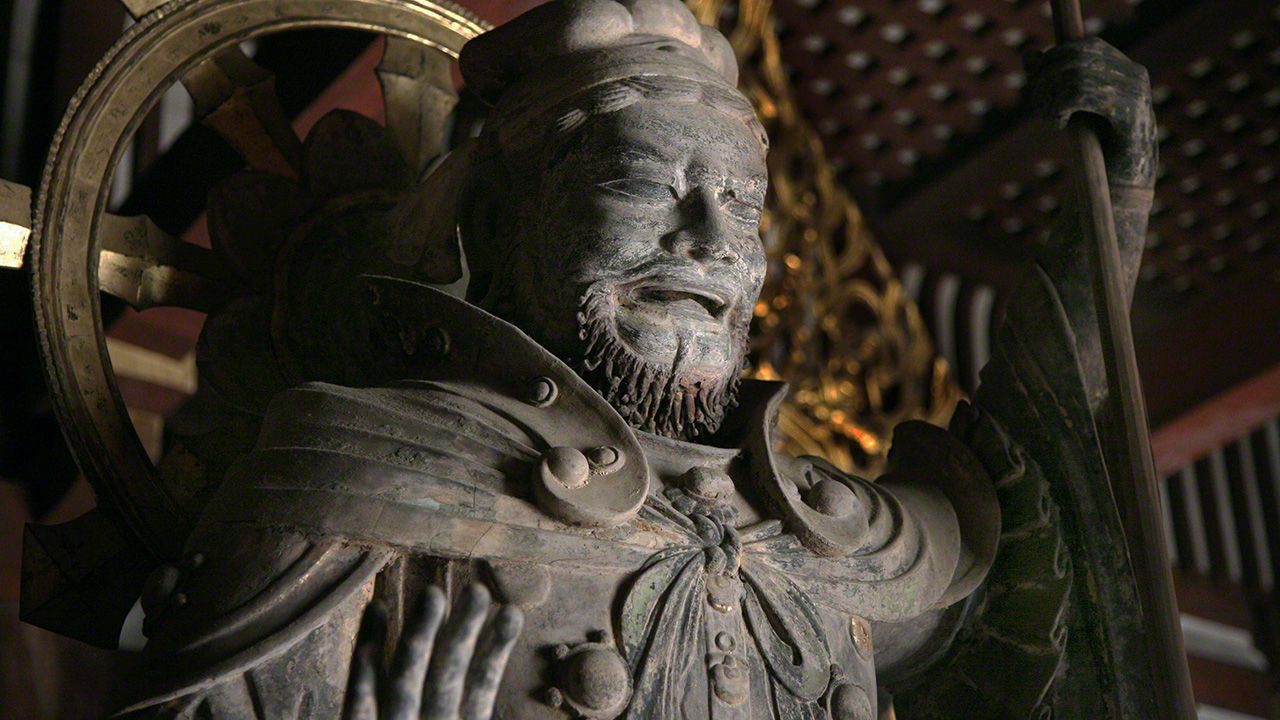
Standing Image of Virudhaka (Zōchōten) at Taimadera
Culture Images History Art- English
- 日本語
- 简体字
- 繁體字
- Français
- Español
- العربية
- Русский
Despite its gentle facial features, this image conveys a fierce determination to fight if necessary.
This statue of Virudhaka (Zōchōten) stands in the Kondō (Golden Hall) at the temple Taimadera in Katsuragi, Nara Prefecture. Virudhaka is one of the Four Heavenly Kings who guard the cardinal directions. He protects the southern realm. Marked by a lush beard on his chin, his facial features evoke the exotic warriors of the Western Regions of China. The style of armor featured in the piece predates the Tang dynasty (618–907), and is reminiscent of Buddhist sculptures made in the Sui dynasty (581–618) or even earlier, during the Northern and Southern Dynasties period (439–589). The figure stands upright, his right arm thrust forward, a spear in his left hand. Despite his relaxed stance, it is clear that no threat will be allowed to pass unnoticed.

(© Muda Tomohiro)
Photographer Muda Tomohiro often visited Taimadera, not far from the family home, as a child, in the company of his grandfather. He vividly remembers how the statue of Virudhaka would emerge from the darkness, illuminated by the soft light that filtered through the wooden slats of the southern door.
According to tradition, Taimadera was founded in 612 by Maroko, the younger brother of Shōtoku Taishi, the prince who was an early patron of Buddhism in Japan. Later, his grandson Taima no Kunimi, who played a key role in suppressing the Jinshin Rebellion in 672, relocated the temple to the eastern foothills of Mt. Nijō, on the border between Nara and Osaka, and gave it its present name.
During the Asuka period (593–710), the Kondō (Golden Hall), with its seated image of Miroku (Maitreya), the Buddha of the Future, was the temple’s main hall. This changed during the Nara period (710–94), when the Mandala Hall (a national treasure) gained prominence owing to the growing importance of the Taima Mandala, a national treasure depicting the Pure Land paradise. According to tradition, the mandala was woven by Chūjō-hime, a noblewoman at court who became a nun.
The mandala became the focus of devotion during the late Heian period (794–1185), when Mappō thought—the belief in the degeneration of Buddhist Law and the coming of the end times—became the dominant strand of Buddhist philosophy in Japan. Chūjō-hime was a legendary figure who took the tonsure and became a nun at Taimadera. She is believed to have woven the famous mandala before entering the Pure Land paradise at the age of 29. Her story appears in nō and bunraku plays.
The seated image of Miroku is the oldest clay statue in Japan, and an outstanding example of Buddhist sculpture from the late Asuka period. The standing images of the Four Heavenly Kings that surround it are all designated Important Cultural Properties. With the exception of the image of Vaisravana (Tamonten), which was made during the Kamakura period, these are the oldest examples in Japan of sculptures made using the dakkatsu kanshitsuzō hollow dry lacquer method. In this technique, the core is modelled first in clay, then wrapped in several layers of hemp cloth soaked in lacquer. Once the lacquer hardens, the core is removed, leaving the hollow outer shell.
The image of Virudhaka can be seen as a pioneering example of an important style that would later produce many of Japan’s finest Buddhist sculptures from the mid-Nara period onward, including the magnificent Ashura at the Nara temple Kōfukuji. Because of differences in style and material, scholars believe that the standing statues and the seated image of Miroku may have been brought to Taimadera from different locations.
Apart from the wooden sculpture of Vaisravana, these are the second-oldest depictions of the Four Heavenly Kings in Japan. According to temple records, they were brought over from Paekche in Korea. The oldest examples can be found nearby, in the Kondō Golden Hall of Hōryūji in Nara.

(© Muda Tomohiro)
Standing Figure of Virudhaka (Zōchōten)
- Height: 2.19 meters
- Date: Late Asuka period (593–710)
- Taimadera, Nara Prefecture
- Important cultural asset
(Originally published in Japanese. Banner photo: Standing figure of Virudhaka [Zōchōten] at the temple Taimadera. © Muda Tomohiro.)


